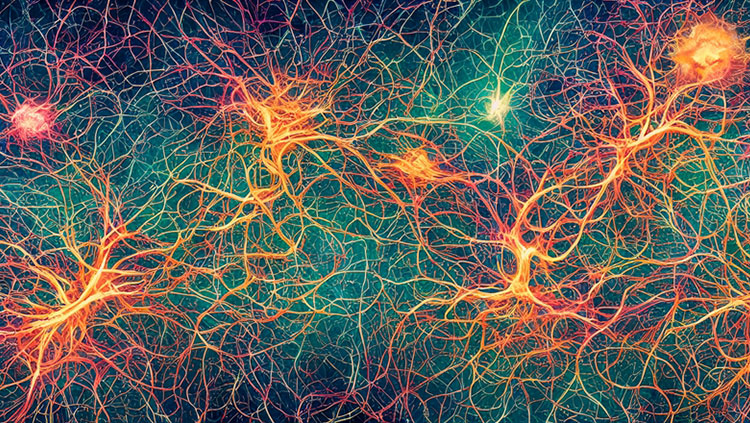Persist or Quit? Study Identifies Decision-Making Hub in the Midbrain
- Published17 Apr 2025
- Author RJ Mackenzie
- Source BrainFacts/SfN
.jpg)
In the first hour after we wake up, we make enough small choices to fill a long, boring Choose Your Own Adventure book. A recent study offers new insight as to how the mammalian brain makes some of those decisions, identifying a small region in the midbrain — part of the brainstem — which plays an oversized role in the process.
Researchers at University College London found three types of neurons in the median raphe nucleus (MRN) whose activity determines whether a mouse will persist at a task, switch to another task, or give up altogether. They say the findings could have implications for our understanding of why some psychiatric conditions can cause people to struggle with toggling between various tasks.
How Neurons Fuel Decision-Making
Behind every decision we make is a microscopic electrical storm of neuronal activity involving multiple brain regions. In this new study, researchers at the Sainsbury Wellcome Centre for Neural Circuits and Behaviour in London focused on the MRN to explore how the serotonin-producing neurons there affect behavior. They also observed GABAergic and glutamatergic neurons, the two other primary cell types in this region. Using a technique called optogenetics, the team directly controlled these cells with fiber optic wires surgically implanted in the mice’s brains. They increased or decreased the activity of each neuron using light emitted from those wires.
The mice then completed a complicated gauntlet of behavioral tests. By switching the three MRN cell types on and off, the researchers drastically altered how the mice performed during a series of tasks. The tests revealed each of the three neuron types controlled a specific aspect of how the mice made decisions.
GABAergic neurons controlled how likely mice were to give up a task, whereas glutamatergic neurons encouraged them to switch to other tasks. Deactivating serotonergic neurons, meanwhile, made mice give up completely. In one test, the mice were presented with objects coated in TMT, a molecule found in fox urine. As a signal of a predator, TMT normally prompts mice to flee. But when GABAergic neurons were suppressed, the mice instead happily sniffed at the TMT as if it were a pleasant rodent cologne. The finding suggests the MRN is a “central behavioral switchboard” influencing decision-making, the authors wrote in their paper.
Decisions often involve a complex combination of behaviors. Deciding to try something new, for example, involves first giving up on your current task. It’s not yet clear how the MRN cell types interact with each other to prompt multiple, interrelated actions at the same time. Ann Kennedy, a neuroscientist and associate professor at the Scripps Research Institute, says decision-making behaviors are likely controlled on somewhat of a sliding scale. The three discrete types of behaviors the MRN cell types can evoke could be reflections of an underlying continuum of engagement with the environment, Kennedy said.
Implications for Mental Health
Some behaviors exhibited by the mice in this study may offer insight into human psychiatry. Sonja Hofer, a neuroscientist and the study’s senior author, said when her team suppressed GABAergic neuron activity, mice which normally engaged with multiple novel objects became fixated on the deep investigation of a single item. “It looks a little bit like compulsion,” she added. This suggests conditions in which compulsive behavior causes distress and anxiety, like OCD, could benefit from a deeper analysis of MRN neurons and the neurotransmitters acting on them.
Hofer says the way mice disengaged from tasks when their serotonergic neurons were suppressed might have clinical implications, too. In humans, the “extreme version” of disengagement is anhedonia, which is an important symptom of depression, she explained, a disorder for which serotonin reuptake inhibitors are the first-choice pharmacological treatment. These compounds affect serotonin levels throughout the brain. If the MRN is found to be important in controlling motivation in humans as well, drugs targeting this specific region could potentially be more effective than traditional treatments for depressive disorders.
The MRN as a crucial decision-making region is compelling — in mice. Whether that remains true for the human brain is an open question. After all, unlike the mice in this study, Kennedy noted, “just because we're afraid of something doesn't mean that we're not going to stick around and investigate it if we have a motivation to.”
CONTENT PROVIDED BY
BrainFacts/SfN
References
What to Read Next
Also In Thinking & Awareness
Trending
Popular articles on BrainFacts.org



















